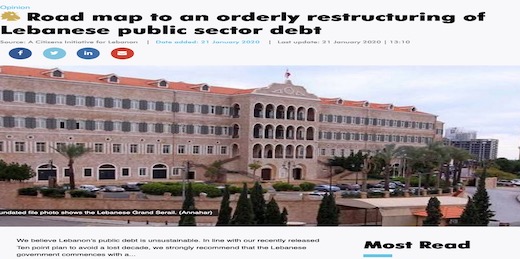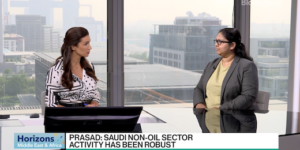The article titled “Road Map to an Orderly Restructuring of Lebanese Public Sector Debt”, written by A Citizens’ Initiative for Lebanon appeared in An-Nahar’s online edition on 21st January, 2020 and is posted below. Click here to access the original article.
We believe Lebanon’s public sector debt is unsustainable. In line with our recently released Ten Point Plan to Avoid a Lost Decade, we strongly recommend that the Lebanese government commences with a comprehensive restructuring effort — one that brings down the debt burden to a level the country can afford. Using scarce international reserves to make future Eurobond payments will be a mistake. Equally, the bond-by-bond rescheduling approach being discussed postpones the inevitable and is costly and inefficient. Sovereign debt restructurings are not un-precedented and best practices do exist. But for the effort be successful, it should be part of a broader stabilization and reform package.
How large is Lebanon’s debt?
Repeated government deficits have led to an extraordinary accumulation of public sector indebtedness. From $25 billion in 2000, gross debt had mushroomed to $90 billion by the end of 2019—the equivalent of 150 percent of GDP. Lebanon today is the third most indebted emerging economy worldwide.
However, this is not the whole story. This debt is likely to continue rising as a result of two additional factors:
- The larger the FX depreciation, the higher the debt/GDP ratio. On the positive side, a large portion of the debt is in Lebanese Lira (LBP). A Foreign Exchange (FX) depreciation will therefore reduce the “real” value of debt. As an indication, if the FX settles at LBP2260/$ (i.e., a 50 percent depreciation), gross debt, when measured in USD, will drop from $90 billion to $71 billion. However, and by the same token, an FX depreciation will reduce the country’s USD-measured GDP. Again, for illustrative purposes, a 50 percent FX depreciation, when combined with a 20 percent inflation and an 8 percent recession, will reduce GDP from $60 billion in 2019 to $44 billion in 2020.1 Consequently, despite the FX-led dilution of LBP debt, debt to GDP will actually rise from 150 percent in 2019 to 161 percent of GDP in 2020.
- Deepening recession and public sector deficits will need to be funded through increased debt. First, the 2020 (and beyond) recession will result in a public sector deficit that will have to be funded through debt. Second, the official (IMF, World Bank, Cedre, etc.) funding support that the country needs will be debt creating. Finally, important quasi fiscal “holes” including, most prominently, BDL’s necessary recapitalization as well as the arrears recently accumulated by the fiscal authorities, will have to be recognized and will inevitably lead to significantly higher debt.
Is Lebanon’s debt sustainable?
No. The easiest way to see this is by examining what it would take to service the existing stock of debt. Given the $71 billion debt figure cited above (which is the debt calculated after the FX
depreciation dilutes the LBP debt but before any new debt is accumulated as described above), a conservatively assumed 7 percent interest rate would lead to $5 billion (annually) in interest
payments. Moreover, if one assumes a seven-year maturity on the debt, there will be an additional $5 billion in annual principal repayments. Combined, this $10 billion represents almost a quarter of 2020’s GDP. Seen in even starker terms, this amount is actually larger than the projected government revenues for 2020.
Lebanon’s debt service burden is not a new phenomenon: it has been large and growing for years now. The government has sustained it thus far by borrowing the debt service and adding the amount to existing debt. However, a future repeat of this approach is extremely unlikely. First, the amount of new debt required to service the existing debt ($10 billion annually) is, in the foreseeable future, almost certainly impossible to raise in capital markets. Second, even if “borrowable”, this will add to an already extraordinarily high level of debt. 2
What’s the “right” level of debt for a country like Lebanon?
The academic literature on debt “tolerance” indicates that emerging economies cannot sustain high indebtedness and that, when they do accumulate it, defaults often ensue.3 The literature’s
conclusion is that, to avoid defaults, an emerging country should hold a relatively “low” debt load. So, what defines “low”? “Investment grade” countries, that is countries seen as having strong
and healthy economies, offer a good benchmark. Historically, those countries have defaulted only 3% of the time. On average, those countries’ debt load amounted to 60 percent of GDP. To
expand the universe a bit wider, countries that are rated three notches below “investment grade” and have defaulted 10 percent of the time, have held a debt load of 80 percent of GDP.
As such, we believe the above range (60-to-80 percent of GDP) is a maximum medium target for Lebanon’s sovereign debt. We would be even more aggressive. Lebanon’s institutional and political fragilities severely challenge the public sector’s ability to generate the budget surpluses needed to service debt over time. We would therefore argue that the lower part of that range is more advisable. Given that Lebanon’s debt today is (at least) 160 percent of GDP, achieving the medium-term target of 60 percent of GDP will require a dramatic debt restructuring effort.
Does a restructuring necessarily mean a “hair cut”?
Not really. Even though the previous section defined sustainable debt in “percent of GDP” terms, the reality is not all debt is created equal. An extreme example illustrates the point: a 100-year bond with zero coupon entails a dramatically smaller debt burden than, say, a 10-year bond with a seven percent coupon.
A more sophisticated way of thinking of the debt load then is to think of it in terms of net present value (NPV). In effect, this means thinking of debt along three different axes: i) the debt’s notional amount; ii) the debt’s interest rate; and iii) the debt’s maturity.
How should the restructuring effort look like?
Following international sovereign restructuring experiences, we would recommend a “menu approach”. Some investors will prefer a principal reduction so long as the interest and maturities remain unchanged. Others will prefer to keep the principal unchanged but could accept lower interest rates and/or extended maturities. The governing principal should be that all creditors are
asked to give the same NPV concession.
Once the negotiations with creditors are completed, the Lebanese government would announce an “exchange offer“ where it retires the existing debt and issues a new set of securities. Some of the new bonds will have lower principal (“discount bonds”) while others will have similar principal (to the existing bonds) but lower interest and longer maturities (“par bonds”). There is also an argument for including “sweeteners” into the exchange (including “warrants” that only pay if the Lebanon grows in the future). International experience suggests that creditors value these warrants thus improving chances of a successful operation.
Is a sovereign debt restructuring a “big deal”?
Yes it is. However, sovereign restructurings are not rare either. Since 1980, there has been 111 cases of sovereign debt restructurings—roughly three a year. This does not mean that debt
restructuring is cost-less or “normal”. There is ample empirical evidence that a stigma, measured by the country’s market risk premium, persists. Nonetheless, restructurings have occurred across the globe and they do not spell Lebanon’s ability to finance itself in international markets in the future.
Are debt restructurings disruptive?
They don’t have to be. If handled properly, they can be cooperative and relatively smooth. Best practices do exist. First, retaining good legal and financial counsel is crucial as the negotiations
will be complicated. Second, it is best not to wait too close to the next maturity before announcing the intention to restructure. The more advance notice creditors are given, the better. Third, Communication matters. In announcing the intention to restructure, the sovereign should make it clear that this is not meant as a “hard default”. By the same token, strong-armed/cramdown
tactics should be avoided if the objective is to reach an orderly and cooperative workout. Finally, fairness and contextualizing the restructuring as part of a broader macro package are
crucial requirements for an orderly effort.
Will creditors be open to a restructuring effort?
Creditors are more likely to be open to restructuring efforts if they are part of a comprehensive macro package that includes official foreign support. It is worth keeping in mind that Lebanese
debt is currently trading at a large discount and investors have already priced in a restructuring. They will therefore be open to offering concessions so long as the value of the new bonds is at or above the market value of the bonds they currently own. In other words, the bar for a deal is not too high and the timing is ripe for entering restructuring discussions with creditors.
We also believe that a credible and well-designed debt workout can actually be advantageous to creditors. If the restructuring is undertaken as part of a strong reform package, a Lebanon without a debt overhang will emerge as much more “creditworthy”. This will translate into a lower “risk premium” which, in turn, could take the value of the new (i.e., post NPV-hit) debt above current valuations. This is not a theoretical possibility: most successful sovereign restructurings have resulted in a country’s bonds, even after a large NPV hit, trading well above the pre-restructured bond levels. For this to be the case, though, the importance of a proactive, orderly, equitable and well-run restructuring process cannot be overstated.
Should the Government be selective in what debt it restructures and what debt it spares?
At the broadest level, comprehensiveness and equality of treatment should be the guiding principle. The size of the debt itself, as well as the challenging fiscal/growth backdrop over the
next few years, mean that the restructuring effort should touch all public sector debt and not just the Eurobonds.
That said, the arguments for selectivity are complicated and not straightforward. First, shortdated LBP debt will be hit hard by the FX depreciation so is probably best spared. Second, while
debt issued under Lebanese law (treasury bonds and BDL claims) is legally and politically easier to restructure, it’s also debt the government will have easiest access to in the future. As such, there is an argument to treat it preferentially. Third, penalizing non-resident creditors is appealing politically and even morally (since most foreign creditors are institutional investors who weren’t coerced to own the bonds and knew the risk they assumed). However, foreign creditors won’t be as cooperative as locals during negotiations and may complicate the process including through lawsuits. In that regard, actions that complicate the Republic’s future return to the capital markets should be avoided if possible.
The bottom line is that there is no straightforward answer to the question of selectivity. The broad principal is that successful restructurings are ones where investors perceive the effort as
“fair” and reasonable.
Is restructuring sufficient to reduce the debt burden?
No. The stock of debt is too large to be brought down solely through a debt restructuring. There are other ways to reduce the burden. As we argued in our 10-point plan, there is scope for the
judicious usage of state assets including privatizations and securitizing future cash flows. Moreover, and as part of any future (large) depositors’ bail in, there is room for swapping some deposits into concessional debt. Finally, the public sector should also assume some of the future burden by running primary surpluses that can be used to gradually lower debt over time.
Is debt reduction alone the answer to Lebanon’s problems?
Absolutely not. It is but one part of the solution. The main argument of our 10-point plan was that a comprehensive stabilization and reform program is a must. Debt restructuring has to be
part of a larger macro package—one that deals with the banking sector, with BDL’s balance sheet, and with private debt. More importantly, a successful debt workout is one that, in parallel,
convinces creditors that the “flow” issues that created the problem in the first place have been dealt with. This, in practice, means addressing Lebanon’s endemic fiscal issues, its large external imbalances, as well as the other parts of the macro policy toolbox such as FX and monetary policy.
Creditors will give the sovereign significantly better terms if they perceive the macro framework as credible and sustainable. There are plenty of examples where restructuring proposals that
were advantageous to creditors ex ante were rejected because the creditors didn’t think the sovereign can follow through with its macro promises.
Will legal complications render restructurings impossible?
We don’t believe so. But they are not straightforward. As noted above, retaining good legal counsel will be crucial to the effort. A broad point is that a cooperative approach will increase the
chances of achieving the thresholds needed for a smooth and orderly restructuring.
Lebanese Eurobonds are issued under New York Law and have broadly standard terms including cross default clauses and a 7 days grace period for principal repayments and 30 days for coupon payments. A quarter of the principal holders are needed for acceleration of the Eurobond’s repayment.
The area that may well complicate the restructuring effort relates to the collective action clauses required for modifying the terms of the Eurobond. The contracts foresee creditors’ meetings that can modify bond terms so long as 75 percent of bond-holders consent. This includes changing amounts payable, reducing/cancelling principal, and modifying currency of payment. Any such resolution passed in this manner would be binding on all holders regardless of whether they voted in favor or not. However, there is no collective action clause across series. As a result, outstanding Eurobonds would have to be restructured series by series. Ownership structure of each Eurobond could thus be an important factor when negotiating with creditors. Our recommendation is that the Government approaches all bondholders across the different series with a single restructuring proposal but we wouldn’t rule out the eventual possibility of differential treatment based on ownership structure.
Summary
In summary, we call on the Lebanese Government to immediately initiate a plan to proactively address the unsustainable debt burden. An organized, fair and credible debt effort that is part
and parcel of a broader reform and stabilization program is imperative for Lebanon’s eventual recovery and its longer-term economic stability and growth.
Signatories in their personal capacities
Firas Abi Nassif, Henri Chaoul, Ishac Diwan, Saeb el Zein, Nabil Fahed, Philippe Jaber, Sami Nader, May Nasrallah, Paul Raphael, Jean Riachi, Nasser Saidi, Kamal Shehadi, Maha Yahya






